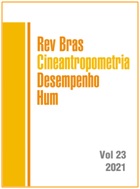Interval training during concurrent training optimizes cardiorespiratory adaptations in women
DOI:
https://doi.org/10.1590/1980-0037.2021v23e73867Abstract
This study compared the effects of using continuous and interval aerobic exercise during concurrent training on cardiorespiratory adaptations in women. Thirty-two participants were randomly assigned into one of the following groups: continuous running and resistance training (C-RUN, n = 10), interval running and resistance training (I-RUN, n = 11), or control group that performed resistance training only (RT, n = 11). Each group trained twice a week during 11 weeks. Oxygen uptake corresponding to the first ventilatory threshold (VO2VT1), second ventilatory threshold (VO2VT2) and maximal effort (VO2max) was measured in a maximal incremental test performed before and after training. Significant increases in VO2VT1, VO2VT2 and VO2max were observed in all training groups. VO2VT2 and VO2max presented time-group interactions, indicating that the magnitude of the increase in these variables was dependent on the training group (VO2VT2: C-Run = 6.6%, I-Run = 15.7%, RT = 1.7%; VO2max: C-Run = 7.2%, I-Run = 14.3%, RT = 2.7%). The effect size observed for post-training values comparing C-RUN and RT groups was d = 0.566 for VO2VT2 and d = 0.442 for VO2max. On the other hand, values of d = 0.949 for VO2VT2 and d = 1.189 for VO2max were verified between I-RUN and RT groups. In conclusion, the use of continuous and interval aerobic exercise during concurrent training improved different cardiorespiratory parameters in women, but in a greater magnitude when interval aerobic exercise was performed simultaneously to resistance training.
References
Kelly CM, Burnett AF, Newton MJ. The effect of strength training on three-kilometer performance in recreational women endurance runners. J Strength Cond Res 2008; 22: 396-403.
Berryman N, Mujika I, Arvisais D, Roubeix M, Binet C, Bosquet L. Strength Training for Middle- and Long-Distance Performance: A Meta-Analysis. Int J Sports Physiol Perform 2018; 13: 57-63.
Chtara M, Chamari K, Chaouachi M, Koubaa D, Feki Y, Millet GP, Amri M. Effects of intra-session concurrent endurance and strength training sequence on aerobic performance and capacity. Br J Sports Med 2005;39(8):555-60.
Paavolainen L, Hakkinen K, Hamalainen I, Nummela A, Rusko H. Explosive-strength training improves 5-km running time by improving running economy and muscle power. J Appl Physiol 1999; 86(5): 1527-33.
Garber CE, Blissmer B, Deschenes MR, Franklin BA, Lamonte MJ, Lee I, et al. American College of Sports Medicine position stand. Quantity and quality of exercise for developing and maintaining cardiorespiratory, musculoskeletal, and neuromotor fitness in apparently healthy adults: guidance for prescribing exercise. Med Sci Sports Exerc 2011; 43(7): 1334-59.
Häkkinen K, Alen M, Kraemer WJ, Gorostiaga E, Izquierdo M, Rusko H, et al. Neuromuscular adaptations during concurrent strength and endurance training versus strength training. Eur J Appl Physiol 2003;89(1):42-52.
Karavirta L, Tulppo MP, Laaksonen DE, Nyman K, Laukkanen RT, Kinnunen H. Heart rate dynamics after combined endurance and strength training in older men. Med Sci Sports Exerc 2009; 41(7): 1436-43.
Ferrari R, Kruel LF, Cadore EL, Alberton CL, Izquierdo M, Conceição M, et al. Efficiency of twice weekly concurrent training in trained elderly men. Exp Geront 2013; 48(11): 1236-42.
Gormley SE, Swain DP, High R, Dowling EA, Kotipalli US, Gandrakota R. Effect of intensity of aerobic training on VO2max. Med Sci Sports Exerc 2008; 40(7): 1336-43.
Swain DP, Franklin BA. VO(2) reserve and the minimal intensity for improving cardiorespiratory fitness. Med Sci Sports Exerc 2002; 34(1): 152-7.
Gibala MJ, Little JP, Macdonald MJ, Hawley JA. Physiological adaptations to low-volume, high-intensity interval training in health and disease. J Physiol 2012; 590(5): 1077-84.
Holloszy JO, Coyle EF. Adaptations of skeletal muscle to endurance exercise and their metabolic consequences. J Appl Physiol 1984; 56(4): 831-8.
Billat LV. Interval training for performance: a scientific and empirical practice. Special recommendations for middle- and long-distance running. Part I: aerobic interval training. Sports Med 2001; 31(1): 13-31.
Midgley AW, McNaughton LR, Wilkinson M. Is there an optimal training intensity for enhancing the maximal oxygen uptake of distance runners?: empirical research findings, current opinions, physiological rationale and practical recommendations. Sports Med 2006; 36(2): 117-32.
MacInnis MJ, Gibala MJ. Physiological adaptations to interval training and the role of exercise intensity. J Physiol 2017;595(9):2915-2930.
Milanovic Z, Sporis G, Weston M. Effectiveness of High-Intensity Interval Training (HIT) and Continuous Endurance Training for VO2max Improvements: A Systematic Review and Meta-Analysis of Controlled Trials. Sports Med 2015; 45(10): 1469-81.
Foster C, Farland CV, Guidotti F, Harbin M, Roberts B, Schuette J, et al. The Effects of High Intensity Interval Training vs Steady State Training on Aerobic and Anaerobic Capacity. J Sports Sci Med 2015; 14(4): 747-55.



